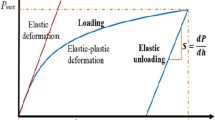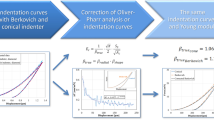Abstract
The accurate description of the indentation load–displacement relationship of an elastic sharp indenter indenting into an elastic half-space is critical for analyzing the nanoindentation data of superhard materials using the procedure proposed by Oliver and Pharr [J. Mater. Res. 7, 1564 (1992)]. A further discussion on this issue is made in the present work to reconcile the apparent inconsistencies that have appeared between the experimental results reported by Lim and Chaudhri [Philos. Mag. 83, 3427 (2003)] and the analysis performed by Fischer-Cripps [J. Mater. Res. 18, 1043 (2003)]. It is found that the indenter size effect is responsible for this large discrepancy. Moreover, according to our analysis, we found that when the deformation of the indenter is significant, besides the errors caused by the Sneddon’s boundary condition as addressed by Hay et al. [J. Mater. Res. 14, 2296 (1999)], the errors induced by the application of reduced modulus should be considered at the same time in correcting the modified Sneddon’s solution. In the present work, for the diamond indenter of 70.3° indenting into an elastic half-space with its Poisson’s ratio varying from 0.0 to 0.5 and the ratio of the Young’s modulus of the indented material to that of the diamond indenter, Ematerial/Eindenter, varying from 0 to 1, a set of new correction factors are proposed based on finite element analysis. The results reported here should provide insights into the analysis of the nanoindentation load–displacement data when using a diamond indenter to determine the hardness and Young’s modulus of superhard materials.
Similar content being viewed by others
References
M.F. Doerner and W.D. Nix: A method for interpreting the data from depth-sensing indentation instruments. J. Mater. Res. 1, 601 (1986).
W.C. Oliver and G.M. Pharr: An improved technique for determining hardness and elastic modulus using load and displacement sensing indentation experiments. J. Mater. Res. 7, 1564 (1992).
D. Tabor: Hardness of Metals (Clarendon Press, Oxford, UK, 1951).
K.L. Johnson: Contact Mechanics (Cambridge University, Cambridge, UK, 1985).
J.S. Field and M.V. Swain: Determining the mechanical properties of small volumes of material from submicrometer spherical indentations. J. Mater. Res. 10, 101 (1995).
N. Huber and C. Tsakmakis: Determination of constitutive properties from spherical indentation data using neural networks: Part I and II. J. Mech. Phys. Solids 47, 1569 (1999).
A.E. Giannakopoulos and S. Suresh: Determination of elastoplastic properties by instrumented sharp indentation. Scripta Mater. 40, 1191 (1999).
M. Dao, N. Chollacoop, K.J. Van Vliet, T.A. Venkatesh, and S. Suresh: Computational modelling of the forward and reverse problems in instrumented sharp indentation. Acta Mater. 49, 3899 (2001).
J.L. Bucaille, S. Stauss, E. Felder, and J. Michler: Determination of plastic properties of metals by instrumented indentation using different sharp indenters. Acta Mater. 51, 1663 (2003).
N. Chollacoop, M. Dao, and S. Suresh: Depth-sensing instrumented indentation with dual sharp indenters. Acta Mater. 51, 3713 (2003).
M. Mata and J. Alcalá: Mechanical property evaluation through sharp indentations in elastoplastic and fully plastic contact regimes. J. Mater. Res. 18, 1705 (2003).
M. Mata and J. Alcalá: The role of friction on sharp indentation. J. Mech. Phys. Solids 52, 145 (2004).
Y.P. Cao and J. Lu: A new method to extract the plastic properties of metal materials from an instrumented spherical indentation loading curve. Acta Mater. 52, 4023 (2004).
Y.P. Cao and J. Lu: Size-dependent sharp indentation: I and II. J. Mech. Phys. Solids 53, 33 (2005).
Y.P. Cao, X.Q. Qian, J. Lu, and Z.H. Yao: An energy-based method to extract plastic properties of metal materials from conical indentation tests. J. Mater. Res. 20, 1194 (2005).
T. Chudoba, N. Schwarzer, and F. Richter: Determination of elastic properties of thin films by indentation measurements with a spherical indenter. Surf. Coat. Technol. 127, 9 (2000).
R. Saha and W.D. Nix: Effects of the substrate on the determination of thin film mechanical properties by nanoindentation. Acta Mater. 50, 23 (2002).
A.E. Giannakopoulos, P.L. Larsson, and R. Vestergaard: Analysis of Vickers indentation. Int. J. Solids Struct. 31, 2679 (1994).
P.L. Larsson, A.E. Giannakopoulos, E. Soderlund, D.J. Rowcliffe, and R. Vestergaard: Analysis of Berkovich indentation. Int. J. Solids Struct. 33, 221 (1996).
J.C. Hay, A. Bolshakov, and G.M. Pharr: A critical examination of the fundamental relations used in the analysis of nanoindentation data. J. Mater. Res. 14, 2296 (1999).
M.M. Chaudhri: A note on a common mistake in the analysis of nanoindentation data. J. Mater. Res. 16, 336 (2001).
A.C. Fischer-Cripps: Use of combined elastic modulus in depth-sensing indentation with a conical indenter. J. Mater. Res. 18, 1043 (2003).
Y.Y. Lim and M.M. Chaudhri: Experimental investigations of the normal loading of elastic spherical and conical indenters on elastic flats. Philos. Mag. 83, 3427 (2003).
A.C. Fischer-Cripps, P. Karvankova, and S. Veprek: On the measurement of hardness of super-hard coatings. Surf. Coat. Technol. 200, 5645 (2006).
I.N. Sneddon: The relation between load and penetration in the axisymmetric Boussinesq problem for a punch of arbitrary profile. Int. J. Eng. Sci. 3, 47 (1965).
T.A. Friedmann, J.P. Sullivan, J.A. Knapp, D.R. Tallant, D.M. Follstaedt, D.L. Medlin, and P.B. Mirkarimi: Thick stress-free amorphous tetrahedral carbon films with hardness near that of diamond. Appl. Phys. Lett. 71, 3820 (1997).
H. Sjostrom, S. Stafstrom, M. Boman, and J.E. Sundgren: Superhard and elastic carbon nitride thin film having fullerene like microstructure. Phys. Rev. Lett. 75, 1336 (1995).
S. Veprek, P. Nesladek, A. Niederhofer, F. Glatz, M. Jilek, and M. Sima: Recent progress in the superhard nanocrystalline composites towards their industrialization understanding of the origin of the superhardness. Surf. Coat. Technol. 108–109, 138 (1998).
S. Veprek and A.S. Argon: Towards the understanding of the mechanical properties of super- and ultrahard nanocomposites. J. Vac. Sci. Technol., B 20, 650 (2002).
ABAQUS Theory Manual Version 6.4 (Hibbitt, Karlsson and Sorensen Inc, Pawtucket, RI, 2004).
Y.Y. Lim and M.M. Chaudhri: Indentation of elastic solids with rigid cones. Philos. Mag. 84, 2877 (2004).
Z.H. Xu and X. Li: Sample size effect on nanoindentation of micro-/nanostructures. Acta Mater. 54, 1699 (2006).
G.H. Fu and A.C. Fischer-Cripps: On Sneddon’s boundary conditions used in the analysis of nanoindentation data. J. Mater. Sci. 40, 1789 (2005).
G.I. Barenblatt: Scaling, Self-Similarity, and Intermediate Asymptotics (Cambridge University Press, Cambridge, 1996).
Y.T. Cheng and C.M. Cheng: Scaling, dimensional analysis, and indentation measurements. Mater. Sci. Eng., R 44, 91 (2004).
W.C. Oliver and G.M. Pharr: Measurement of hardness and elastic modulus by instrumented indentation: Advances in understanding and refinements to methodology. J. Mater. Res. 19, 3 (2004).
R.B. King: Elastic analysis of some punch problems for a layered medium. Int. J. Solids Struct. 23, 1657 (1987).
J.J. Vlassak and W.D. Nix: Measuring the elastic properties of anisotropic materials by means of indentation experiments. J. Mech. Phys. Solids 42, 1223 (1994).
Author information
Authors and Affiliations
Corresponding author
Rights and permissions
About this article
Cite this article
Cao, Y.P., Dao, M. & Lu, J. A precise correcting method for the study of the superhard material using nanoindentation tests. Journal of Materials Research 22, 1255–1264 (2007). https://doi.org/10.1557/jmr.2007.0150
Received:
Accepted:
Published:
Issue Date:
DOI: https://doi.org/10.1557/jmr.2007.0150




